BIRDS AS ART BULLETIN 245
Visit www.birdsasart.com
BRAND NEW SW FLA IPT ANNOUNCED
“MY PICTURES DON’T LOOK LIKE THAT”
THE CANON EOS 40D
THANKSGIVING LUNCH
QUICK MASK BRAIN TYPO…
CRACKED SOUNDBOARD TRAVEL TIPS
BAA KUDOS
BEAR BOAT OPENINGS
ROBERT O’TOOLE STUFF
IPT UPDATES
Contact us by phone at 863-692-0906 (Eastern Time Zone) or by e-mail at birdsasart@att.net or @verizon.net. The att e-mail address is best from overseas.
We gladly accept credit card orders by phone 8am till
You can use the PayPal links on the web site to order anything. Just type in the item(s) and the amount. If using your own PayPal account, please send to either of the e-mail addresses above.
Photographic theme: two of my all-time favorite images from Little Estero Lagoon and some more of my best photographs from the recently concluded Kenya Photo-Safari.
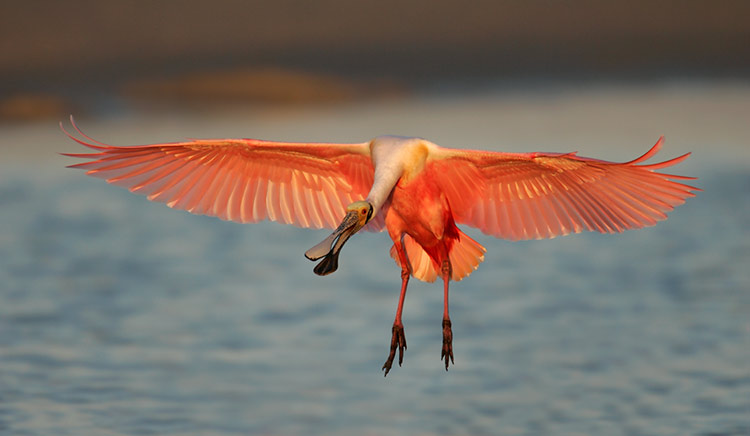
Roseate Spoonbill landing in early morning light, Little Estero Lagoon, Fort Myers Beach, FL
Image Copyright 2005: Arthur Morris/BIRDS AS ART
Canon 600mm f/4L IS lens with 1.4X II TC and EOS-1D Mark II. ISO 400.
Evaluative Metering +1/3rd stop: 1/800 sec. at f/5.6.
This is one of my very favorite spoonbill images. With any luck, those on the new SW FLA IPT (see below) will have some great chances with this species.
BRAND NEW SW FLA IPT ANNOUNCED
As I will be in Tanzania and Madagascar during the week of the traditional President’s Day SW FLA IPT I have decided to offer the IPT below just prior to the Easter holiday. Last year in mid-March Little Estero Lagoon was fantastic with lots of birds and lots of Roseate Spoonbills so we will be likely spending two or three days there. If you sign up, prepare to get your feet wet.
SW FLA President's Holiday IPT: MAR 17-21, 2008 5-DAY: $1669. (Limit 14). Slide program on the evening Sunday, MAR 16, 2007. Co-leaders: Robert O’Toole, Alfred Forns, Fabiola Del Alcazar, & Robert Amoruso. Sanibel Island, Little Estero Lagoon, Venice Rookery, Cape Coral. Herons, egrets, gulls, terns, skimmers, shorebirds, both pelicans, Osprey, Burrowing Owl, and lots more.
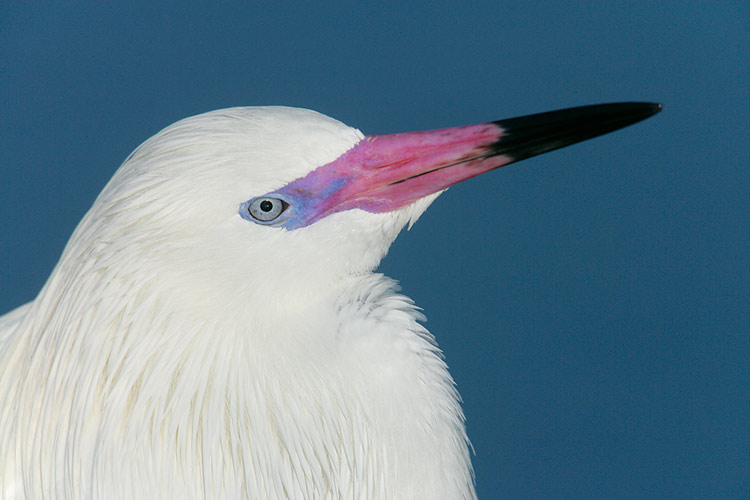
Reddish Egret white phase, head portrait in early morning light, Little Estero Lagoon, Fort Myers Beach, FL
Image Copyright 2006: Arthur Morris/BIRDS AS ART
Canon 600mm f/4L IS lens with 2X II TC and EOS-1Ds Mark II. ISO 250.
Evaluative Metering -1/3 stop: 1/1000 sec. at f/13.
Because I was working at close range and had lots of light, I opted for a small aperture and more depth-of-field. We have photographed this bird three years running at Little Estero. Only on a BAA IPT will you wind up at the eastern end of the lagoon when the light is perfect….
“MY PICTURES DON’T LOOK LIKE THAT”
The first time that I heard those words was in the Galapagos this year. Betty Wisse was looking some of my trip images on my laptop when she said, “My pictures don’t look like that. I have great equipment and I am standing right next to you, but my pictures don’t look like that.” Since then I have been thinking about what she said, and when I heard the same thing come out of the mouth of Sam Hogue on the recent Photo-Safari I gave it some more thought and decided to write a short piece addressing the possible solutions to the problem…
#1: And I say this often on IPTs, there is one big secret to becoming a successful nature photographer. The secret is that there is no big secret, just lots of little secrets, lots of paying attention to small details. Each small secret/technique/trick that you learn and assimilate into the way you do things will make your images a little bit better, and the more little things that you learn to do better the better your overall body of work will become over time.
#2: Though digital has made things 1,000 times easier, getting better does require some effort. Countless times on IPTs I suggest that someone do something a bit different and have had the participant respond, “I know that.” I hold my tongue and resist saying what is on my mind,” OK, you know that but are choosing not to do it because you do not care to improve the quality of your images; is that correct?”
#3: In the same vein, it seems that many folks are too lazy to do the work, to study, to learn to become better nature photographers. They spend thousands, sometimes tens of thousands of dollars on equipment and travel, but do not put in the time to look at great images, to study, to practice. Sometimes it baffles me. Some of the folks who join us regularly on IPTs attend for social reasons, to hang out, meet other photographers, and be part of the scene. I can understand their not working hard to improve. But many of the folks who profess to want to get better simply do not put in the time, the effort, and the work that is required to become a more proficient photographer.
#4: OK, what are the specific areas where folks need to improve? The quick answer is all areas. You have to do many things correctly to create a good image. As with flying an airplane if you do 19 of 20 things right and one thing wrong you crash… If you find a great subject, put yourself in the right place, choose the right focal length, design a gorgeous image, and get the exposure right but do not create the sharp image that you wanted, you get to hit the delete key. If you do everything right but do not recognize that you are trying to create a good image in an impossible situation, then you will fail. If you recognize a great situation and do nearly everything perfectly but blow the highlights, the image will not be successful. Nature photography pretty much demands perfection; that is why folks need to do the work, put in the effort, and practice.
#5: Here, in no particular order, are some of the things that you need to learn to do:
a-Study the natural history of your subjects. Learn their habits and preferences. Become a good field naturalist, a better birder, and a decent biologist.
b-Find a pleasing subject and learn to recognize a good situation. One way to do that is to look at as many good and great images as you possibly can.
c- Figure out exactly where to be before you press the shutter button. This involves developing your creative vision while understanding perspective, light angle, head angle, and subject-to-film plane or imaging sensor orientation.
d-Be able to design a pleasing composition quickly and know how to use your AF system to create the composition that you want.
e-Get the exposure right or very nearly so on your first attempt.
f-Make your images sharp when you want them to be sharp and learn to create pleasingly blurs that imply motion or create exciting patterns.
g-Understand the qualities of natural light.
h-Use your camera’s AF system to create sharp images of birds and animals in action or in flight.
i-Use your flash effectively as fill and as main light. For the latter, learn to work in both ETTL (automatic) and Manual flash modes.
j-Make your images look better in Photoshop (not worse as most folks do… The big sins here include sharpening your optimized master files before they are sized for a given use, over sharpening JPEGs for presentation, and over-saturating your images.
As you can see, it will require quite a bit of effort and quite a bit of work on your part to improve. Lots of folks think that if they buy the best equipment they will become better photographers by osmosis. Nothing could be further from the truth. If you put an off-brand 300mm lens and a cheapo digital camera into the hands of John Shaw, Darrell Gulin, or Tim Fitzharris, I can guarantee that they will go out and create some striking images. It ain’t the camera and it ain’t the lens boys and girls…
If you want your images to look as good as those of the top professionals, you’ve got to do the work.
When I started more than 24 years ago, there was not a lot of great information around. There was nothing good on exposure and not much on how to use a long lens. Heck, for the first seven years that I photographed I had no idea that lenses more than 400mm existed. Today, you can go to various locations and see ten, twenty, even fifty 500 and 600 mm lenses in action (can you say Bosque in November?).
Some folks can learn from on-line forums (coming soon???). Others learn from books. Others will benefit greatly from attending an IPT or another photographic tour or workshop. Still others learn best in a seminar or classroom setting. In any case, folks today who truly wish to get better have tons more resources available than I did more than two decades ago. And I am proud of my contributions as a photographic educator, probably more proud than I am of my accomplishments as a photographer…
Literally speaking, “The Art of Bird Photography; The Complete Guide to Professional Field Techniques” served as the how-to bible for most of today’s successful bird photographers. Though currently out of print and unavailable, we will be re-publishing it on our own with the next six months (or possibly sooner). Next on tap was Digital Basics which has helped more than 2,000 folks learn to optimize their digital images quickly and efficiently with pleasing results. Digital Basics was followed up by the ground-breaking “The Art of Bird Photography II (ABP II on CD only). At 916 pages with more than 875 color photographs (each with our legendary educational captions) the CD book details everything that I learned about bird photography from 1998 until the time of its publication in late 2006. In a short time, we have sold more than 2,200 copies of the CD book. Lastly we published Robert O’Toole’s APTATS PDF that teaches folks (including me) to use Quick Masks for a variety of Photoshop chores. Learning to use Quick Masks has totally changed the way that I optimize my images.
Add in more than a dozen “The Art of Nature Photography; It Ain’t Just Birds” seminars, more than a dozen BIRDS AS ART Instructional Photo-Tours, Photo Safaris, and Photo Cruises each year for the past ten years, thousands and thousands of e-mails answered, 245 BIRDS AS ART Bulletins, our seven Photographic Site Guides, and lastly, the Mark III User’s Guide, and it is easy to see why I am so proud of my contributions as a photographic educator, instructor, author, and tour leader. If you want to learn to be a better bird or nature photographer, BIRDS AS ART is here to help, but you will still need to do the work.
BAA resources:
The BAA Bulletin Archives: http://www.birdsasart.com/bn.html
The Art of Bird Photography; The Complete Guide to Professional Field Techniques (temporarily out of print)
Digital Basics: http://www.birdsasart.com/digitalbasics.htm
ABPII: http://www.birdsasart.com/ABPII.htm
Robert O’Toole’s APTATS: http://www.birdsasart.com/aptats.htm
BAA Site Guides: http://www.birdsasart.com/siteguides.htm
Mark III User’s Guide: http://www.birdsasart.com/MARK%20III%20USER%20GUIDE.htm
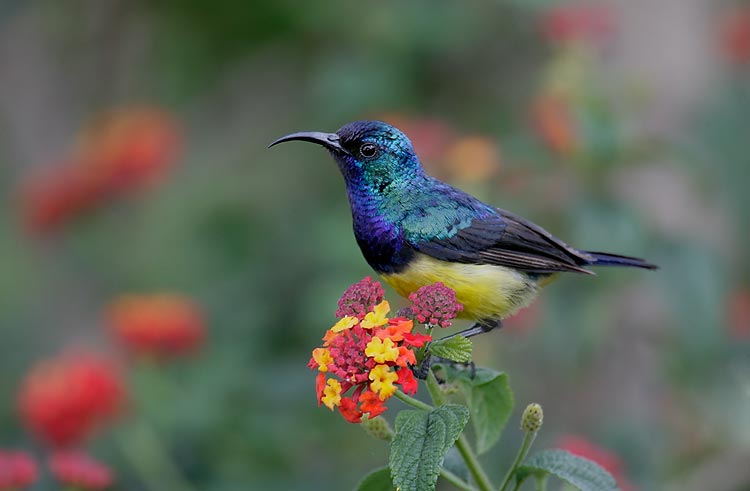
Variable
Sunbird, Elsamere, Lake Naivasha,
Image Copyright 2007: Arthur Morris/BIRDS AS ART
Canon 500mm f/4L IS lens with the 2X II TC and the EOS-1D Mark III. ISO 800. Evaluative metering +2/3 stop: 1/125 sec. at f/8. Fill flash at -2 stops.
Many of us were ion perfect position around this flowering bush when this gorgeous sunbird came back to gather some nectar. Upon seeing this image, several in the group said, “My pictures don’t look like that!” Using the 10 fps of the MIII to my advantage, I created about 40 images of this bird in less than a minute; I wound up keeping only two…
THE CANON EOS 40D
Subscriber Jim Knoy wrote asking that I share my thoughts on the Canon EOS 40D. Here is what I had to say:
When the 10D came out I bought one, tried it for a while, and sold it. When the 20D came out, I bought one, tried it for a while, and sold it. Can’t remember if I purchased a 30D, but I did use one for a while. Now there is the Canon EOS-40D. I have not tried one and at present, have no plans to try one. My preference is to use the Canon professional digital camera bodies; I currently own and use three Canon EOS 1D Mark III camera bodies and have a 1Ds Mark III on order.
With each generation of Canon pro-sumer bodies, from the original D-30 to the 10D to the 20D to the 30D to the 40D the cameras have improved dramatically while the price has usually dropped (or stayed the same at worst). The 40D features a 10.1 Megapixel APS-C CMOS sensor, 6.5 fps continuous shooting, a new AF system with 9 cross-type sensors, the DIGIC III processor, a 3” LCD with Live View mode, the amazing EOS Integrated Cleaning System, a clearer and brighter viewfinder, and customizable Picture Style processing parameters. And let’s not forget the 1.6 crop-factor that is a huge plus for bird photography. What’s not to love??? In my travels I have come across many photographers who have used and depended on one of the pro-sumer bodies, and many of those folks are quite skilled.
With these bodies you still have autofocus when using a 1.4X teleconverter on an f/4 lens. When using the 2X teleconverter on an f/4 lens, however, you will need to focus manually or use the tape-the-pins trick to get very, very slow AF. The 1.6 crop-factor pretty much makes up for the difficulty of using the 2X… With a 500mm lens, the 1.4X II TC, and the 40D, you will have an effective focal length of 1120mm. Not shabby by any standards. So while I do not use a 40D I can recommend it with complete confidence for folks with limited budgets.
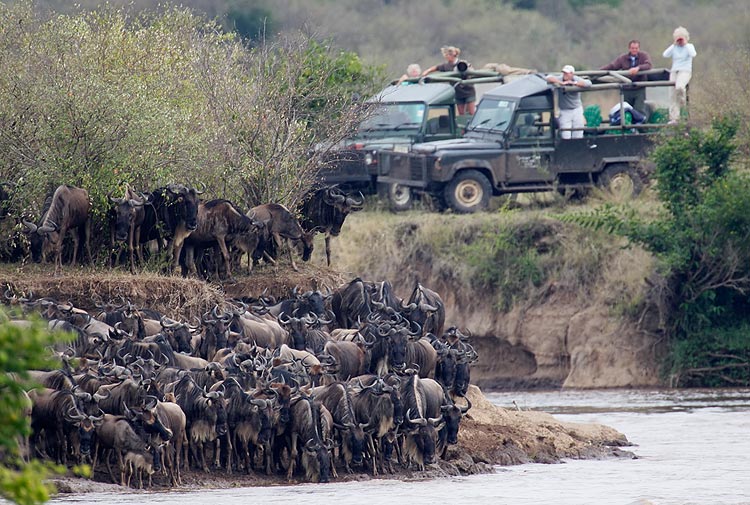
Wildebeest ready to cross, Maasai Mara, Kenya
Image Copyright 2007: Arthur Morris/BIRDS AS ART
Canon 500mm f/4L IS lens with the 2X II TC (Wimberley head and Todd-Pod) and the EOS-1D Mark III. ISO 400. Evaluative metering +1/3 stop: 1/320 sec. at f/8 in Manual mode.
One of my rules for good composition states that if an object is worth including in the frame, you must include the whole object along with a border. By framing carefully and including both the safari van and the woman with the binoculars in the upper right corner, I created an interesting image with significant potential for stock sales.
THANKSGIVING LUNCH
On Thanksgiving Day,
For the third consecutive
year, the lunch will be held at the
The cost of the complete lunch will be $35. This will include several courses including your main course, a dessert, a non-alcoholic beverage, and the tip. If you have wine or a cocktail with your meal you will need to pick up the tab for that.
All reservations must be
paid for in advance by check only—no Paypal or credit cards. If you would
like to join us please let us know by e-mail that you will be sending a check
(made out to “Arthur Morris”) ASAP to us here:
If you will be joining us,
please plan on being at the
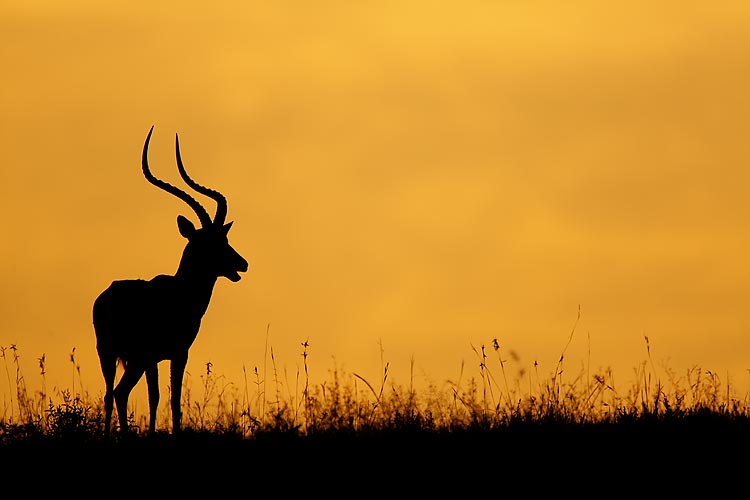
Impala buck, dawn silhouette, Lake Nakuru, Nakuru National Park, Kenya
Image Copyright 2007: Arthur Morris/BIRDS AS ART
Canon 500mm f/4L IS lens with the 1.4X II TC and the EOS-1D Mark III. ISO 400. Evaluative metering +2/3 stop: 1/500 sec. at f/5.6.
The morning after I saw a similar image that Todd had created, I lay awake for more than an hour dreaming of it. It was my last morning of the safari so when we headed out into the park at 6:30 am and found the same animal on the ridge I was thrilled and amazed. I set my White Balance to 9500 K to enhance the sunrise colors.
QUICK MASK BRAIN TYPO…
From Don Boroughs of South Africa via e-mail:
Hi Artie, I’ve been reading your bulletins with great interest, even if I’m getting to them a couple of weeks late. In #242 you wrote the following of Quick Masking:
“Here are the very basics: Control Q, B, Control Q, Control J, V. It’s that simple.”
But Robert O’Toole once wrote the following:
“Eliminating Photoshop’s sudden death shortcut
This is a strongly recommended option for any Photoshop (CS-2 or 3) user, especially an APTATS user.
The default EXIT shortcut of Ctrl+Q will, without any dialog, immediately close any open images without saving then close Photoshop. At first I was convinced I had a virus on my PC when I inadvertently pressed Ctrl+Q instead of the normal ‘Q’ as the Quick Mask shortcut. To eliminate this potential problem, access the shortcuts menu (Alt+Shift+Ctrl+K or Edit>Keyboard shortcuts) and then delete the shortcut as follows: 1. Press the Keyboard shortcuts tab. 2. Check shortcuts for: application menus. 3. Press the file drop down arrow to access the menu commands. 4. Navigate to the bottom of the field for the Exit command—it is the last white line before the grey lines begin to appear, then click in the shortcut column, press backspace to delete the Ctrl+Q shortcut. 5. Press Accept. 6. Press OK to finish. To prevent this default shortcut from ever reappearing save the shortcut menu change by going to Window>Workspace>Save Workspace and make sure to click the Keyboard shortcuts box. Name the workspace, I recommend using the date as the name. Then press save.”
Since I followed his instructions, pressing Ctrl-Q does nothing on my system, but won’t it Quit instead of Quick mask under normal circumstances? Shouldn’t you have written Q instead of Ctrl-Q? Best, Don
Don was of course totally correct. I should have written the following: “Here are the very basics: Q, B, Q, Control J, V. It’s that simple.”
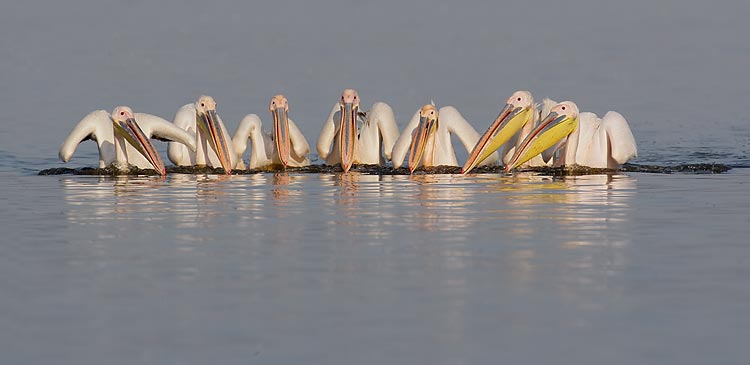
African White Pelicans feeding, Lake Nakuru, Nakuru National Park, Kenya
Image Copyright 2007: Arthur Morris/BIRDS AS ART
Canon 500mm f/4L IS lens with the 2X II TC and the EOS-1D Mark III. ISO 400. Evaluative metering +1/3 stop: 1/800 sec. at f/11.
As I was using the central sensor only I was forced to center these birds in the frame (from top to bottom) knowing all that while that I would employ a panoramic crop. A single extraneous bird that merged with one of the feeding birds was removed from this image using a combination of Quick Mask (APTATS) and select, protect and clone techniques (Digital Basics). Can you tell where it was???
CRACKED SOUNDBOARD TRAVEL TIPS
After I published the tale of my KLM Business Class travel woes, subscriber John Lampkin sent me the article below. John, a musical composer, self-publishes “The Cracked Soundboard,” a monthly musical humor newsletter available by e-mail subscription only. Once a month folks receive a single-page column written by John in their online mailbox. Some issues are graphics with very little text. Others are text-only essays. All are original, clever, and totally free! To subscribe to The Cracked Soundboard please email John. To download a sample issue as a pdf file, click here. Or visit John’s web site at www.JohnLampkin.com.
I am positive that you will find his Travel Tips story totally amazing…
“Travel Tips” by John Lampkin
In early September 2006, during our vacation on a remote mountaintop in the Sierras of central Mexico, my wife Jane began to exhibit serious symptoms of a mini-stroke in the middle of the night. Our tour guide immediately evacuated us by car to the nearest hospital in modern Chihuahua, Mexico. Within an hour of entering the emergency room, I was viewing CT-scans of Jane’s brain expecting to see a small blood clot which would be typical for a mini-stroke. Instead, the monitor showed a meningioma tumor the size of a small orange. I immediately asked for the chief neuro-surgeon. Within an hour, he was there to give us our options, to fly home to the USA with considerable risks, or to undergo an immediate emergency surgery. Since Jane’s symptoms were becoming exaggerated almost by the minute, it was an obvious choice, and one which we haven’t regretted for a moment. The next day, in a nine-hour operation, a medical team removed the troublemaker, a benign meningioma, and a smaller fibroma as well. Jane spent a week recuperating at the hospital, then another week in a nearby apartment which I rented. After the doctors gave a safe-to-fly thumbs up, we returned home. Now, just four weeks after the surgery, Jane looks good and feels good, and is well on the road to complete recovery.
Throughout the ordeal, we received incredible support from friends and strangers. Everyone at the hospital from the housekeeping staff to the team of doctors, and even the Hospital General Director gave Jane world-class, professional, personal and loving care and attention. Caravan Tours provided us with a translator and facilitator, and On Call International monitored us daily, and booked our return flight prepaid for us. We made many new friends, most of whom we will never see again. But they will always have a place in our hearts. We can only repay their many kindnesses by being Good Samaritans ourselves. One thing I myself can do is to use this month’s column to share some travel tips from things I have learned:
• Expect the unexpected. If disaster does strike, it is important to remain positive. If your companion is the one in distress, you yourself must be positive for two people. There is plenty of time to worry after you’re dead.
• Don’t be afraid to tell your story to people you meet. We actually had two days of fun exploring the city just before we left, with a family who were happy to have our companionship. Almost all people have big hearts.
• Always take out travel insurance. On Call International was terrific. There are others. Read the fine print. Remember: Medicare will NOT pay for medical care abroad.
• Tour companies are a good idea, especially for older travelers. They will be responsible for your safety. Caravan was spectacular. Carlos Rivera, our guide, may have saved Jane’s life or her brain from permanent damage through his quick and effective middle-of-the-night actions. Carlos Perez, our Caravan assistant in Chihuahua was equally superb. He even loaned me his Mexican cell phone for our entire stay! Our experience would have been radically different had we been independent travelers.
• Always bring a laptop computer and charger. After all, www means world-wide-web. I always carry a phone wire connector just in case dial-up is the only option.
• Don’t use your USA cell phone while abroad. Don’t call from hotels. Don’t use calling cards. The charges are exorbitant. Instead use an internet company like Skype.com, and talk from your laptop for pennies to anywhere in the world!
• Always bring at least double the cash you think you will need. Divide it between your party members.
• Know your credit card pin numbers.
• Use your credit card to pay for everything you can for the best exchange rate.
• If you have a good credit history, your credit card companies will help if you ask. It took exactly 15 seconds for American Express to give us an additional $10,000 line of credit when I called from the hospital on day one.
• Always leave a house key and access to car keys, important documents, etc. with someone you trust to help out at home in an emergency. (Thank you daughter Jemma!)
• Believe in prayer.
Thank you all for your prayers and good wishes. May your own travels be trouble free!
John Lampkin is a composer with a serious photography addiction. Visit him at www.JohnLampkin.com
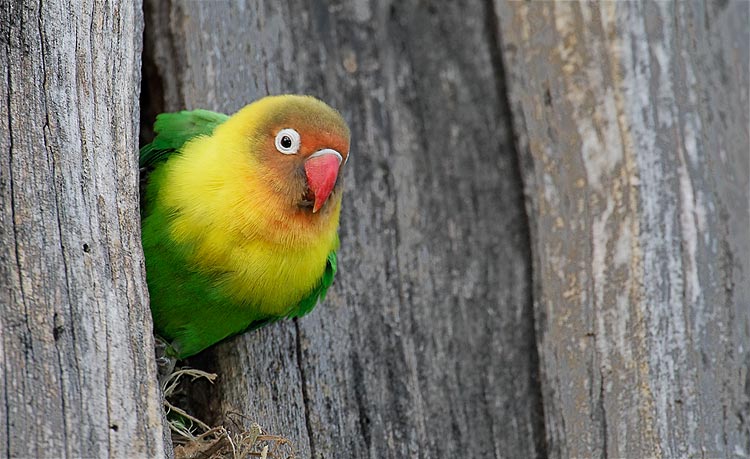
Fischer’s Lovebird, Lake Naivasha, Kenya
Image Copyright 2007: Arthur Morris/BIRDS AS ART
Canon 500mm f/4L IS lens with the 2X II TC and the EOS-1D Mark III. ISO 1600. Evaluative metering +1/3 stop: 1/80 sec. at f/9. Fill flash at -2 stops.
Todd’s knowledge of little-know photo locations for specific, difficult-to-photograph birds and animals is remarkable. We made a late- afternoon trip by van just to photograph the lovebirds. Here, I used One-Shot AF and recompose to create the off-centered composition that I wanted. Mark III images are simply amazing at the higher ISO settings…
BAA KUDOS
I received this by e-mail from Elizabeth Lodwick via e-mail. :
Hi Artie, This is a long overdue letter. I bought ABP II months ago and have really enjoyed it. Hopefully I have learned from it. I absolutely love looking at the pictures and reading how you did it. I will never have your eye or patience but I can appreciate what you do. I took two Photoshop classes a while back but Photoshop is so immense that last week I bought your Digital Basics and have read it carefully; it reinforced the need to get exposure correct at the beginning, to expose to the right.
Today I received APTATS and I have to tell you that that it is the most fun I have had in a long time. In doing the exercises I keep saying, I can’t believe that that works. I have pulled out old pictures and used the Quick Mask techniques. They are just amazing. I keep looking for pictures that I can fix. I know what you are thinking and you are correct: I need to take an IPT. Until then I will continue to re-read and study ABP II. Thanks for all the hard work that went into writing that and know that it is greatly appreciated. Elizabeth.
You can learn more about Digital Basics here: http://www.birdsasart.com/digitalbasics.htm, and more about ABP II here: http://www.birdsasart.com/ABPII.htm
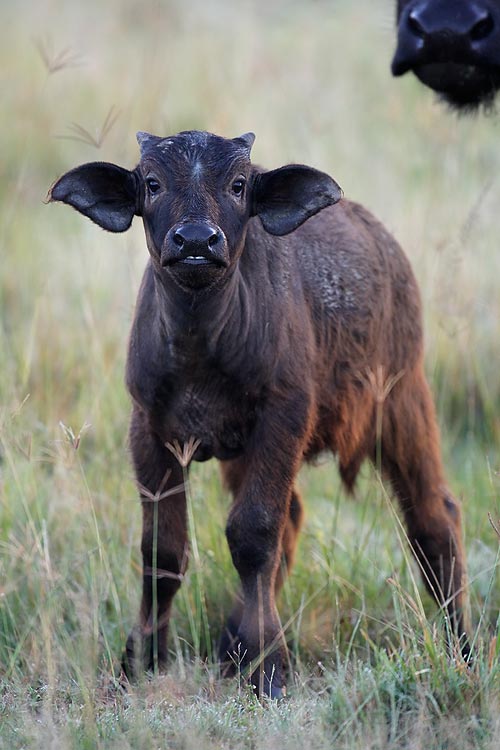
Cape Buffalo, young, Lake Nakuru, Nakuru National Park, Kenya
Image Copyright 2007: Arthur Morris/BIRDS AS ART
Canon 500mm f/4L IS lens with the EOS-1D Mark III. ISO 800. Evaluative metering -1/3 stop: 1/250 sec. at f/4.
Nakuru was absolutely packed with Cape Buffalo. Here I could have easily Quick-Masked out the momma buffalo’s nose but opted to keep it in to create a feeling of protection. I love the wispy stalks of the grasses.
BEAR BOAT OPENINGS
Due to two cancellations and some musical chairs, space has opened up on these two trips as follows:
Bear Boat Trip #1:
Bear Boat Trip #2:
Please e-mail for additional details.
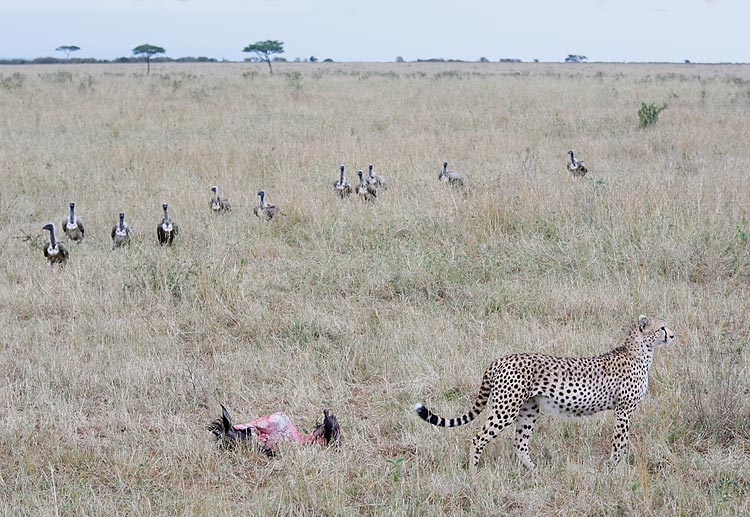
Cheetah and vultures, Maasai Mara, Kenya
Image Copyright 2007: Arthur Morris/BIRDS AS ART
Canon 70-200mm f/4L IS lens handheld at 104mm with the EOS-1D Mark III. ISO 1600. Evaluative metering +2/3 stop: 1/250 sec. at f/5.6.
As the fifth and last Cheetah was ready to leave the kill, the vultures ran right toward it. I always have two additional camera bodies mounted to various lenses within easy reach when I am working from a safari van. Here it paid off.
ROBERT O’TOOLE STUFF
NOVEMBER 2007 Bosque Del Apache New Mexico APTATS Workshops: http://www.aptats.com/bosque2007.html
Bosque del Apache Workshop1: NOV 12th, 2007. $399 3 openings
Bosque del Apache Workshop 2: NOV 16th, 2007. $399 4 openings
Bosque del Apache Workshop 3: NOV 21st, 2007. Sold out.
DECEMBER 30, 2007 South West Florida APTATS Workshop: http://www.aptats.com/aptats_december2007.html
JANUARY, 19, 2008 San Diego APTATS Workshop: http://www.aptats.com/san_diego_2008.html
FEBRUARY-MARCH 2008 Best Of Florida APTATS Workshops: http://www.aptats.com/aptats_florida.html
Workshop 1: March 17-18, 2008
Workshop 2: March 27-28, 2008
Workshop 3: April 20-21, 2008
JULY 4-10, 2008 Coastal Brown Bear Workshop: http://www.aptats.com/bears_july_2008.html
SEPTEMBER 10-16, 2008 Coastal Brown Bear Workshop: http://www.aptats.com/bears_sept_2008.html
IPT UPDATES
Bosque #1: "The Fall Color IPT"
Bosque #2: "The Pre-Thanksgiving IPT"
Bosque #3: "The Post-Thanksgiving IPT"
San Diego IPT:
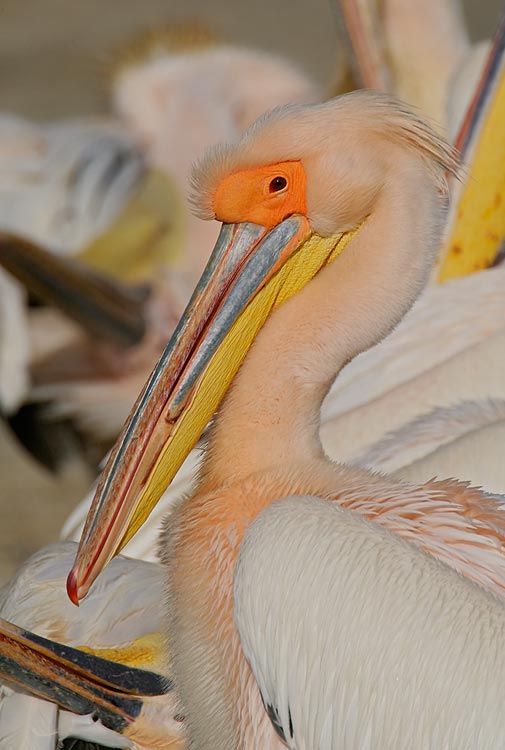
African White Pelican in insane breeding plumage, Lake Nakuru, Nakuru National Park, Kenya
Image Copyright 2007: Arthur Morris/BIRDS AS ART
Canon 500mm f/4L IS lens with the 2X II TC and the 1.4X II TCs stacked and the EOS-1D Mark III. (Wimberley head with Todd-Pod.) ISO 320. Evaluative metering +1/3 stop: 1/500 sec. at f/11.
We found some large roosting flocks of African White Pelicans on the shore of Lake Nakuru at about 8:45am. The light was bright (the sun gets up quickly on the equator!), but there was a bit of mist in the air that softened it a bit. Of about 150 birds, only two or three were in full breeding plumage with the fluorescent orange knob. It was pretty much impossible to isolate any of them, so I resorted to stacked teleconverters. With the fairly bright sunlight, I knew that the system would autofocus. The trick is to use One-Shot (rather than AI Servo) AF. I keep the beep turned on so that I can hear the confirmation beep when correct focus is achieved. With most cameras, I would be subtracting a bit of light in this situation, but with Highlight Tone Priority enabled, a check of the histogram revealed that this was not necessary.
Best and love and great
picture-
artie
Note: Arthur Morris has been
a Canon contract photographer since 1996
and continues in that role today. Hunt's Photo of Boston, MA is a BAA sponsor
as is Delkin
Devices. Back issues of all BAA Bulletins can be found in the Bulletin
Archives which